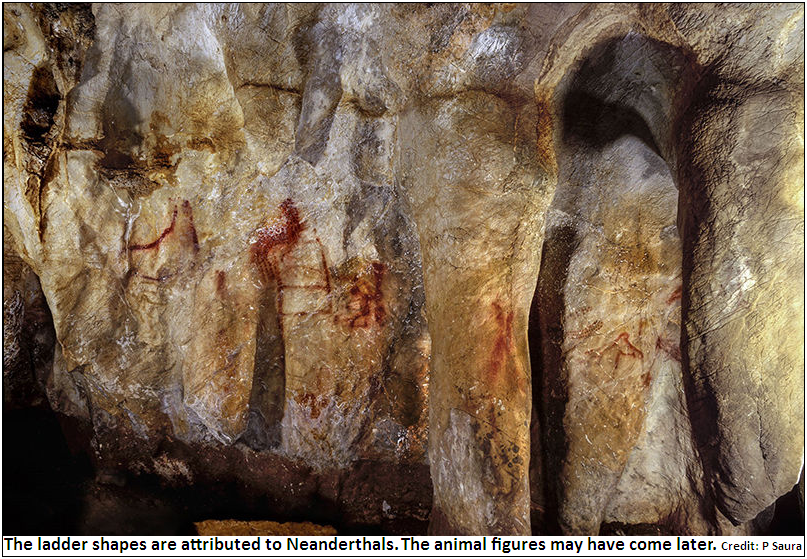Remains of archaic humans discovered in Spain suggest that it is not, says S.Ananthanarayanan.
Homo sapiens, modern man, is considered to be a distinct species that first appeared in the African continent, from which it migrated to Asia and Europe. ‘Homo’ is the genus, or group of species, and ‘sapiens’, which means, ‘wise’, denotes the only human species that has survived. Older or other extinct species are known as ‘archaic humans’. Modern man is believed to have separated from the ancestral species, Homo erectus, over a quarter of a million years ago and all related species disappeared some 30,000 years ago.
While there is evidence of a progression in the kinds of tools used by ancient humans and some related species, symbolic representation, in the form of cave art, has been discovered only where there were human settlements. Art and ornament use has hence been considered a distinguishing attainment. A discovery reported in the journal, Science, however, re-examines this position. D. L. Hoffmann, C. D. Standish, M. García-Diez, P. B. Pettitt, J. A. Milton, J. Zilhão, J. J. Alcolea-González, P. Cantalejo-Duarte, H. Collado, R. de Balbín, M. Lorblanchet, J. Ramos-Muñoz, G.-Ch. Weniger and A. W. G. Pike, from institutes in Germany, Spain, UK, Portugal and France report that they have dated samples of cave art in three sites in Spain to be 65,000 years old, which is earlier than humans are known to have appeared in Europe.

This dating of the cave art suggests that it was the work of Homo neanderthalensis, an archaic human species which went extinct 40,000 years ago. Neanderthals, so named because of fossils first discovered in the 19th century in Neandertal, in Germany, are generally considered a separate species and may have descended from a separate branch of Homo erectus that migrated to Europe. Neanderthals share 99.7% of their DNA with humans, compared to the 98.8% by chimpanzees. Neanderthals, however, are not considered ancestors of humans, though they may have contributed to the human DNA through interbreeding.
The 400 or so Neanderthal remains that have been discovered suggest that they had a more robust build and distinctive head and facial features, a reduced chin, and a large nose, shorter limb proportions and a wider, barrel-shaped rib cage. It is believed that they were furry. This belief arises from the ridges found in the bones of their fingers, which are like those of chimpanzees, whose young clutch their mothers’ fur, and unlike humans’.

Reasonably good remains of the Neanderthals have been found, including hundreds of stone tools. There is evidence that they used wooden spears, which suggests that they were hunters. They had also discovered the use of manganese dioxide to help ignite wood and were familiar with fire. For all this, however, there has been an ongoing debate about whether they produced any forms of art or ornamentation.
The earliest cave art known so far is the Chauvet cave, in central France, whose impressive drawings of animals are dated at over 32,000 old or even 39,000 years old. These are clearly the work of modern humans, as the Neanderthals were extinct by then. A more ancient discovery, by Alistair Pike, the leader of the present study, is a smudged red disc in the El Castillo cave in northern Spain, dated to more than 40,800 years. Whether this is in fact a Neanderthal creation, however, is not certain as the date could overlap with the arrival of humans. Ancient cave art has also been found in the East, but the antiquity of 40,000 years has not been bettered. A notable instance is the find of Indonesian hand prints, similar to those found in European caves, apart from drawings of local animals. But these have been dated to 39,900 years ago.
In contrast, the discovery now reported is of ladder-like markings, dots and handprints deep in caves in three sites in Spain and dated at 65,000 years ago. As humans are thought to have come to Europe from Africa only 40-45,000 years ago, this would be an instance of art that predates humans - and questions the notion that symbolic representation is a human feature. Clarity on this question is of importance, as art implies the ability for thinking in symbols, a capacity we need for language and some forms of social organization, or for religion, to arise.
The usual method of dating archeological artifacts or material is by carbon dating of organic matter in the samples. Living tissue contains two forms of carbon, one the normal carbon and another, a radioactive form, in a fixed ratio. But when an organism dies, as when it is fosilised, the radioactive carbon decays and the ratio of the two forms of carbon changes. How far the change has gone then reveals how long ago it was that the organism died.
This method does not work with cave art because cave art does not have associated organic matter. Dating of cave art is hence done by an indirect method, of dating the limestone-rich coating that forms on the paintings, as a result of mineral-rich water dripping over them. The mineral content has traces of radioactive uranium, but not of thorium, into which uranium decays. A fresh mineral coat would thus contain uranium but very little thorium. An older layer, on the other hand, would lose its uranium content, while thorium accumulates.
An objection to dating a sample in this way is that the ratio of uranium to thorium could be affected by water washing some of the water soluble uranium away. The sample would thus show a higher thorium component and suggest that it was older. Pike and his team dealt with this problem by carefully scraping away the mineral layer on the paintings and collecting the material in three lots, from the exposed surface, from a little below and from nearest the painting itself. The three layers showed that the outer layer, which would be the most recent, was the youngest and the age increased as one went deeper, or closer to the painting. If it is washing by water that is making the mineral coat appear older than it is, then it is the outermost layer that should appear to be the oldest. As it is the innermost layer that shows the greatest age, this would be the correct age of the painting, the team concludes.The finding represents an important resolution of the question of symbolic representation, in the form of art, having been practiced by a pre-human species. The discovery has implications in anthropology, psychology and theories of language and communication. Taken along with other discoveries of ancient cave art in Africa and of ornaments fashioned and used by Neanderthals in other locations, the discovery would bring about a reassessment of the idea that there is something essentially special about being human.
------------------------------------------------------------------------------------------ Do respond to : response@simplescience.in